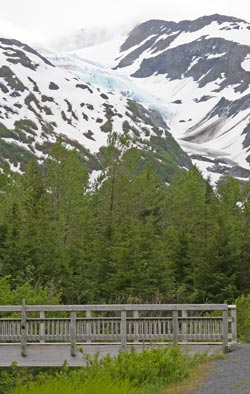Portage Glacier Valley

Notable Species
- Chum salmon
- Coho salmon
- Pink salmon
- Sockeye salmon
- Beaver
- Black bear
- Moose
- Mountain goat
- Harlequin
- Common goldeneye
- Greater yellowlegs
- Rufous hummingbird
- Ice worm
Bigger creatures like moose thrive in the dense brush, with cows and newborn calves browsing along ponds throughout the valley in May and June. Both black and brown bears roam the valley, but black bears are more visible. Watch for sows and cubs eating greens in the meadows on the steep slopes to the north. Mountain goats forage on the valley walls. Look for them in spring on the slopes overlooking the lake, usually near the green-up line.
During spring and fall bird migrations, great flocks of geese, ducks, swans and cranes wing through Portage Pass, taking the short cut between Turnagain Arm and Prince William Sound. Summer fills the forest with songbirds, and harlequin ducks return to nest on fast-moving streams. Lucky viewers may be startled by the flutter of a hummingbird’s wings.
By August, four species of salmon start arriving in streams and ponds. A viewing platform and a bike trail at Williwaw Creek near milepost 4 provide intimate views of spawning coho, sockeye and chum salmon.
Habitat
Portage Glacier Valley is a mosaic of habitats. You can see stages of post-glacial plant succession—from bare rock to temperate rainforest—along several trails. The valley also contains many avalanche paths, filled with alders and other plants adapted to surviving snow slides. Humans have dredged ponds and channels in the valley to enhance salmon runs. The 750-foot Portage Pass, accessible from the Whittier side of the highway tunnel, is the lowest-elevation alpine habitat on the Kenai.
Cultural Connection
Alaska Natives and prospectors used Portage Pass and the valley as a travel corridor between Prince William Sound and Turnagain Arm.
Viewing Tip
A snowfield at the end of the Byron Glacier Trail offers the easiest place to view ice worms in the region. The tiny creatures surface en masse in the evening after the sun retreats and dusk deepens. Related to earthworms, the miniscule ice worms have evolved to live only at temperatures near 32 degrees Fahrenheit.
Stay off active glaciers and snowfields unless you’re prepared for glacier travel.
Helpful Hints
The Begich, Boggs Visitor Center is an essential first stop for wildlife viewing advice, naturalist guided walks, and current alerts about any avalanche danger and bear activity.
The visitor center is open daily Memorial Day through Labor Day. Call 907-783-3242 or 783-2326 for the current hours of operation. Closed winters. See also: USFS Chugach National Forest webpage.
Accessible Sites and Trails
The US Forest Service maintains the following sites and trails that are accessible to people with disabilities. All have firm and smooth travel surfaces and are under 5% grade. Except for cooking surfaces, the campgrounds meet accessibility guidelines.
- Moose Flats Day Use Area (mi 1.5 Portage Glacier Road) has picnic sites, a wetland interpretive trail and wood fishing platform, great waterfowl viewing and the occasional moose. The area is at the west end of the Trail of Blue Ice, which continues on almost 5 miles to Portage Lake and connects to all sites listed here.
- From the Explorer Glacier Pullout (mi 2.5 Portage Glacier Road) a short trail leads to the Upper Explorer Pond and a view of Explorer Glacier across the water. Beavers, waterfowl and eagles are often seen here. Eagles are especially abundant in fall when they congregate to feed on spawning salmon.
- Black Bear Campground (mi 3.7 Portage Glacier Road) has compacted gravel surfaces.
- Williwaw Fish Viewing Platform (mi 4 Portage Glacier Road) is an excellent spot to view spawning salmon from mid-July through the end of August. The Williwaw Nature Trail follows the creek then joins the Trail of Blue Ice to create an approximately 2-mile loop around Williwaw Campground.
- Williwaw Campground (mi 4.2 Portage Glacier Road) is paved.
- Portage Lake/Begich, Boggs Visitor Center (mi 5 Portage Glacier Road) is located at the east end of the Trail of Blue Ice.
Getting There
Seward Highway milepost 78.9. The Whittier–Portage Glacier Access Road runs southeast about five miles toward the shore of Portage Lake and the highway tunnel to Whittier in Prince William Sound.
